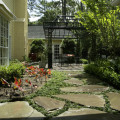Stone Landscaping

Stone is a naturally durable substance that you can use to decorate virtually any landscape. It can work as a supportive element of a garden or ornamental feature, or it can work as a primary element to a special style or earthwork. It also provides an incredible building material that can not only weather the elements better than synthetic materials, but also blends architecture more effectively with Nature. Stone occurs side-by-side with vegetation in the natural world, and as such will look like an appropriate compliment to almost any garden or landscaping motif you choose to add to your property.
Think all sizes of stone when you think about using it to landscape your property. Gravel is perhaps one of the most inexpensive and versatile materials in which you can invest. For example, many different types of gardens use gravel beds to provide both aesthetic compliment and natural drainage for water. In French parterre gardens, gravel pathways provide transit areas and decorative patterns that cut through the vegetation, forming intricate designs in the process. Areas around statuary, birdbaths, and certain types of fountains can also be greatly magnified with a gravel foundation. One popular design strategy is to use stones that contrast the color of the figure being highlighted. If a statue or structure is made from white marble or similarly colored materials, surrounding it with black or gray gravel creates a sense of separation which draws attention to the form.
Similar accenting can be achieved around natural pools and disappearing fountains by using alternating colors of stones to create either a blend of light and dark elements or a checkerboard design. Natural swimming pools can be constructed using stone landscaping elements instead of concrete. Stone coping can be made to imitate rocks around a waterfall, and larger, flat rocks can replace diving boards. Even the steps leading down to the pool can be made from rock instead of metal.
In other stone landscaping designs, such as the Zen garden, sand and larger stones constitute the majority of the design. Sand is spread over the ground to represent the energetic constitution of the universe. Larger stones of contrasting colors are then arranged in patterns to represent the material forms that arise out of patterns of energy. This simple juxtaposition of large and small elements, dark and light colors, allows the Zen gardener to work with an infinite number of combinations that represent states of mind, frames of reference, and representations of both real and imagined structures.
An equally important role that stone plays in landscaping is as a building material for outdoor structures. Patios that are constructed out stone look more natural and inviting than concrete. They seem to somehow blend with grasses, flowers, and other indigenous plant species as if they are part of the garden itself. Flagstone walkways that meander through gardens certainly look better than a series of concrete slabs. Other structures such as outdoor rooms andoutdoor fireplaces can also be built of stone instead of brick. This makes them appear to be rise up out of the landscape as if formed by the earth itself.
As a substance that literally forms the bedrock of forests, grasslands, and ecosystems, stone can be used to build columns and walls that create a sense of unity between human engineering and the forms and forces of the Natural world. The limits to what you can do with stone are defined only by your own imagination, the size of your property, and the architecture of your home.





